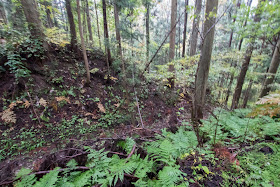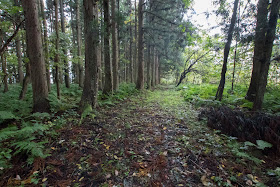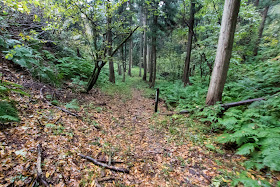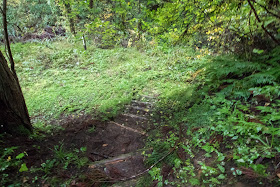Sakenobe Castle
-Castle of brave general like fish in water-
Overview
Name: Sakenobe castle (Sakenobe-jo)
Alias: Mamuro-jo (Mamuro castle)
Place: Uchimachi Mamurogawa town, Yamagata
Type: Hill Castle
Built: 16th century
Remaining remnants: Clay walls and dry moats
Title:
Brief History
Sakenobe castle (鮭延城) is built over river terrace of Mamuro-gawa river which is 30 meter height from hillside, at the south edge of current Mamurogawa town. Mamuro-gawa river is the tributary of Mogami-gawa river which runs from most north point, and from its source it is connected to Akita prefecture only passing Okachi-Toge pass.
It is a bit detour route compared with straight route used as current Route 13, but it was not necessary to pass Syunezaka-toge pass additionally. Therefore, Ou-honsen line uses Mamuro-gawa river route and unnaturally curves at the north of current Shinjo city. Today Mamuro-gawa river is known for its clear stream and running up salmons, along with its mother stream Sake-gawa river.
Origin of Sakenobe clan
Precise year is unknown but Sakenobe castle was built by local lord Sakenobe clan in the former half of 16th century. Sakenobe clan was originally a branch family of Sakaki clan, a traditional family from Minamoto clan and prospered at Omi province (Shiga prefecture) such as Rokkaku clan or Kyogoku clan.
Around the end of 15th century, Tsunamura Sakaki (?-?) left their original territory and moved to Dewa province, then was hired by Onodera clan which was the traditional lord of Yokote basin. Onodera clan was appointed as the administrator of Okachi area (south half of Yokote basin) by Kamakura Shogunate in 13th century, and gradually grew their power based on fertile Yokote basin.
Onodera clan overcame its internal conflict in the middle of 16th century aggressively expanded its territory into northward and southward. At northward, its territory reached to Kakunodate area, the north edge of Yokote basin. And at the southward, it crossed Okachi toge pass and entered into Shinjo basin already around 1530.
Entrance into Shinjo basin and build of castle
At that time Shinjo basin was a vacuum of authority became two neighbor strong lords, it mean Mogami clan at Yamagata basin and Daihoji clan at Sakata plain significantly declined because of internal conflicts. Looking at this opportunity, Onodera clan once seized whole part of Shonai basin and sent Sadatsuna Sakenobe (?-?) as the commander of new territory.
It was a distant territory but Sakenobe clan was trusted by Onodera clan as Kagemichi Onodera (1534-1597), the leader of Onodera clan, married with the female of Sakenobe clan. Sakenobe clan moved to Shinjo basin as a relative of Onodera clan and managed whole part of the basin including current Shinjo city area, Kanayama area and Mamurogawa area.
It is said that Sakenobe clan at first built their castle at Iwahana area, where was the southwest end of Shinjo basin and river side of Mogami-gawa river. But in 1563, Daihoji clan attacked Shinjo basin from downstream of the river, and Sakenobe clan was broken. Hidetsuna Sakenobe (1563?-1646) was once took away by Onodera clan, and Sakenobe clan lost the south half of Shinjo basin then retreated to Mamurogawa area.
Sakenobe clan newly built Sakenobe castle at the place of Sakenobe as their new main base, and changed their sir name from Sasaki clan to Sakenobe clan. Soon Daihoji clan changed their policy to cooperate with Onodera clan and expand into Yuri area of current Akita prefecture. Hidetsuna was returned to his territory, and Sakenobe clan developed their remaining territory and Sakenobe castle.
Structure of Sakenobe castle
Sakenobe castle utilizes the plateau half separated from backside by two valleys. Rough shape of the castle is S shaped, and currently it is a single flat area of 200 meter long and 150 meter wide but formerly it might be separated into three part. Central area of the castle is the north part, which faces Mamuro-gawa river.
As south part of the castle is directly connected to backside plateau by ridge of 50 meter wide, this point was securely protected by combination of three layer dry moat with clay bridge at the center. Outside of these dry moats it seems small main gate area which is encircled by dry moat but it is not clear. Side of this area is protected by vertical dry moats to prevent detour of enemy.
East line of the castle is the main gate of the castle connected to north valley, and this part is protected by layer of terraces built at the slope. Enemy intruded from main gate is exposed to the attack from upward central area and these terraces. Backside gate of the castle is at western slope and also protected by layers of terraces.
Attack of Mogami army
In the latter half of 1570’s, Yoshiaki Mogami (1546-1614) who forced his father Yoshimori Mogami (1521-1590) and left Mogami clan from the effect of Date clan started his campaign to unite Yamagata basin. After tough battles against Tendo clan or Sagae clan, Yoshiaki at last united Yamagata basin in 1585.
At the same time Yoshiaki started expansion to next area of Yamagata basin, it mean Shonai basin and Sakata plain. In 1583 Yoshiaki already assassinated the leader of Daihoji clan by complaint his retainers, and substantially seized Shonai area, then could concentrate whole army to attack Shinjo basin.
Next year in 1584, Yoshiaki let his general Mitsunobu Nobesawa (1544-1591) attack Sakenobe castle. Hidetsuna Sakenobe well resisted against Mogami army then rejected, but next year Yoshiaki himself encircled Sakenobe castle. Yoshiaki placed his army to surrounding plateau and repeatedly attacked the castle.
Activation like a fish in water
Hidetsuna again well resisted against superior Mogami army, but there was no reinforcement army from Onodera clan because of distance and confusion by leader change. Among the shortage of supply retainers of Sakenobe clan turned to Mogami army by the plot of Yoshiaki, and finally Hidetsuna surrendered to Yoshiaki.
Yoshiaki evaluated the braveness of Hidetsuna, then forgave him and used as a vanguard toward Onodera clan. From then Hidetsuna well activated at both of battle and coordination against Onodera clan, like a fish in water. The sir name of Sakenobe clan derived from salmon of the area (Sake means salmon), it would be more appropriate to express as “like a salmon in water”.
In 1586, a large battle occurred between Onodera army which tried to attack Sakenobe castle across the border, and reinforcement army of Mogami clan occurred at Ariya-toge pass. Onodera army broke Mogami army at first battle but Mogami army revenged at second battle by brave fight of Hidetsuna, then there was no clear result but Onodera clan could not intrude into Shinjo basin any more.
Continuation of conflicts surrounding Mogami clan
After the unification of Japan by central ruler Hideyoshi Toyotomi (1537-1598), Mogami clan and Onodera clan still continued their conflict. South part of Yokote basin was confiscated from Onodera clan and was given to Mogami clan by Toyotomi government, but Onodera clan did not leave it to Mogami clan.
In 1595, Mogami army including Hidetsuna Sakenobe attacked Yuzawa castle. Michitame Yagashiwa (?-1595), an intelligent retainer of Onodera clan was purged by the plot of Yoshiaki, and some retainers turned to Mogami army by negotiation of Hidetsuna. Finally Mogami army fell Yuzawa castle and could seize south edge of Yokote basin.
In 1600, correlating the conflict between Ieyasu Tokugawa (1543-1616) and Mitsunari Ishida (1560-1600) after the death of Hideyoshi Toyotomi, Mogami clan entered into the battle against Kagekatsu Uesugi (1556-1623). Uesugi army had four times of Mogami army then fell border castles and approached to Yamagata castle (Yamagata prefecture), the main base of Mogami clan.
Braveness no less than Kenshin and Shingen
At this battle Hidetsuna Sakenobe was at Hasedo castle (Yamagata prefecture), the last fortress before Yamagata castle, as a vice commander. Mogami army only had 1,000 soldiers against 18,000 soldiers of Uesugi army, but Mitsuyasu Shimura (?-?) and Hidetsuna well resisted against overwhelming enemy.
Mogami army lead by Mitsuyasu Shimura and Hidetsuna Sakenobe made night assault to Uesugi army then approached to the camp of its commander Kanetsugu Naoe (1560-1620) and gave rise to confusion. Brave fight of Hidetsuna at this battle was evaluated by Kanetsugu as “braveness of Hidetsuna is no less than those of past great lords such as Kenshin (Uesugi, 1530-1578) and Shingen (Takeda, 1521-1573)”.
As a result of the battle of Sekigahara between Ieyasu and Mitsunari, Uesugi army retreated thus Mogami clan could survive and seize Shonai plain. Mogami army also attacked Onodera clan which belonged to Uesugi clan, thus Onodera clan lost their territory and was finally expelled from its main base Yokote castle (Akita prefecture).
Afterward of Sakenobe clan and Sakenobe castle
Under the Mogami clan which became one of the largest feudal lord, Hidetsuna Sakenobe was affirmed his territory with Sakenobe castle and became an important retainer. However in 1619, after the death of Yoshiaki, Mogami clan was confiscated its territory due to severe internal conflict by Edo Shogunate.
Hidetsuna was exiled to Doi clan, an important retainer of Shogunate at Sakura castle (Chiba prefecture) and became its retainer. According to the tale, his 20 loyal retainers followed and did everything to feed their master even by begging, and Doi clan head this story hired Hidetsuna as their retainer. Hidetsuna divided all of his territory to these 20 retainers, and stayed each of the houses of retainers day by day to the death.
After the leave of Mogami clan, Tozawa clan became the lord of Shinjo basin and once used Sakenobe castle as main base. But it was too distant from Mogami-gawa river and inconvenient, thus disposed Sakenobe castle and newly built Shinjo castle. Structure of hilltop area was destructed at this time, and all building were taken away or broken.
Now no building remains and structure of hilltop area was lost but terraces or dry moat around hilltop area still remain. Thick clay walls and layers of terraces well show the tension this castle was enclosed. The single layer structure of the castle without depth also expresses the braveness of its commander, even though being surrounded by deep valley.
Access
15 minutes walk from JR East Ou-Honsen line Uzen-Toyosato station. 30 minutes drive from Tohoku Chuo Jidoshado Expressway Shinjo-Kita interchange.
Related Castles
Hasedo Castle -Another campaign in Eastern Japan (3) time’s up-
Yokote Castle -Can not live under same sky-
Shinjo Castle -Long history of small clan-
Sakura Castle -Official residence of ministers of Edo shogunate-


























































































































































No comments:
Post a Comment